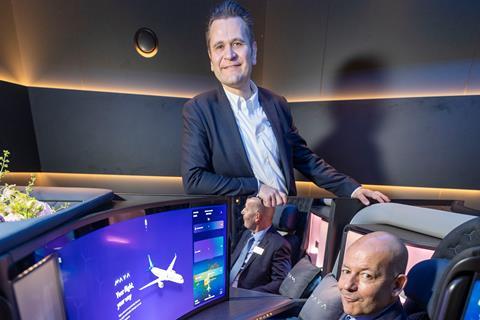While Panasonic Avionics and Collins Aerospace opened AIX by presenting their concept for the next generation business class suite, the in-flight entertainment company’s vice-president product management Andy Masson stresses this vision is based on real and in-development technologies.
The MAYA concept suite features an ultra-widescreen, ultra high-definition curved OLED display as a centre-piece together with a headphone-less audio system.

”Everything you see is real and is being developed,” says Masson. ”The screen for example – the 45-inch OLED – this is part of the Astrova line. The only new thing on the screen is the screen itself; the seat-box, the harnesses, the peripherals, they are all existing products. The screen itself we think will be ready by the end of 2026, the integration of that into the seat is where the complexity will come in.
“So it will be ready probably in around 18 months with the screen, then we will have to engage with seat companies. Obviously if you do it with Collins it is going to be much sooner because they are a year ahead, but if its another seat company it will be how quickly can they build a product with the engagement in it.”
Panasonic has been working with Collins on the integrated concept for the past year and Masson flags that this shows what is possible when an IFE and seat company start with a clean sheet of paper.
Masson argues that the concept brings business class ”back to the forefront” of the technology space. “It had started to get overtaken by automotive, consumer electronics etc. You would get in a Tesla and they would have the big screen and all these applications, and you get in aeroplane and it was kind of the same as it has been for the last few years.
”What we have done is create that big jump that takes you to that next level where you have a very large engagement digital window, with a whole host of digital applications, highly integrated.”
Another feature of the suite is an audio system that means headphones become options.
”If you want to wear your headphones, you can wear your headphones. However if you don’t want to wear your headphones, you don’t have to anymore,” Masson explains. ”It has a very special acoustic system built into the headrest – we use a special kind of acoustic mirror array which enables the audio to stay completely focused in a bubble of audio around you – and base speakers built into the seat itself.”
“What you are seeing there I would say is exactly what you are going to get up to in the next few years,” he adds. ”If you want to differentiate yourself as an airline this is the kind of product you are going to see. And we didn’t want to build something that isn’t real.”


























